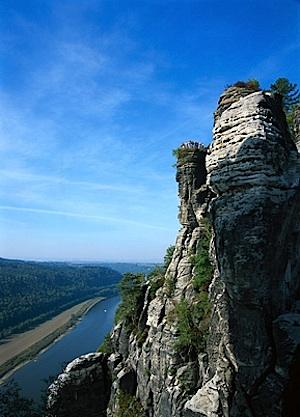
Nagelfluhkette Nature Park/German National Tourist Board
After the United States launched the national park movement in 1872 with the creation of Yellowstone National Park, many countries built on the movement. Germany has more than a dozen national parks, ranging from coastal parks to parks that claim high alpine terrain and scenery. Here's a quick primer on those parks.
Bavarian Forest National Park: 243 square kilometres, largest unbroken area of protected forest in central Europe, foot paths, cross-country ski trails, cycle routes.
Berchtesgaden National Park: mountains, fantastic walking trails, scenic lakes and dense forests, Lake Königssee, diverse local wildlife, variety of tours and activities e.g. salt mines, cable car.
Black Forest National Park: currently Germany's newest (Jan 2014), harsh climate, high rainfall, mixed mountain forests.

Holstein Switzerland Nature Park/German National Tourist Board
Eifel National Park: first conservation area to protect upland beech forests on acidic soil, habitat for more than 230 endangered plant and animal species, Forest Experience Centre in Gemünd.
Hamburg Wadden Sea National Park: 12,000 hectares of coastal mudflats, small group of islands, smallest of the three Wadden Sea parks.
Hainich National Park: Germany 's newest UNESCO World Natural Heritage site, rare animals such as wildcats and black storks.
Harz National Park: mountainous region, unforgettable scenery, Germany's most northerly mountain range, Mount Brocken, interesting trails, red deer, roe deer and wild boar, as well as birds, Brockenbahn steam railway.
Holstein Switzerland Nature Park: hilly lakeland scenery, unspoiled natural areas, encounter Germany's national bird, the white-tailed eagle.

Harz National Park/German National Tourist Board
Kellerwald-Edersee National Park: 5,700 hectares, unspoiled nature, no roads, settlements or railway lines, guided tours, walks and cycle routes through the national park are available.
Lower Saxony Wadden Sea National Park: provides protection for the Wadden Sea, coastal area of mudflats, characteristic salt marshes, great diversity of flora and fauna.
Lower Oder Valley National Park: meadowland, scarce and protected birds, 40 types of fish and 50 different species of mammal, river cruises.
Müritz National Park: many lakes, animals: white-tailed eagle, pairs of ospreys in Federow and cranes, ancient beech forests, boats.
Nagelfluhkette Nature Park: Lake Constance, close to the Alps, idyllic towns, rare animals, waterfalls.
http://www.germany.travel/en/leisure-and-recreation/natural-landscapes/naturpark-nagelfluhkette.html
Schleswig-Holstein Wadden Sea National Park: largest national park in central Europe, largest continuous mudflats landscape of the earth, wetlands, coastal landscape of dunes, beaches and salt marshes.

Saxon Switzerland National Park/German National Tourist Board
Schwalm-Nette Nature Park: woodlands, fens, lakes, walking and cycling trails, watermills, castles.
http://www.germany.travel/en/leisure-and-recreation/natural-landscapes/naturpark-schwalm-nette.html
Saxon Switzerland National Park: more than 36,000 hectares, Elbe Sandstone Massif, close to Dresden and the Elbe, one of a kind in central Europe, rare animals.
Western-Pomeranian Boddenlandschaft National Park: largest nature reserve on the Baltic coast, landscape of cliffs and dunes, spits and lagoons, plenty of guided walks, red deer and wild boar.

 Support Essential Coverage of Essential Places
Support Essential Coverage of Essential Places







Comments
Thanks for the nice reminder that the national park idea has caught on in other parts of the world. For comparison sake, a hectare = about 2.5 acres, and a sq. kilometer = about 0.4 sq. miles or 247 acres.
That means the "largest unbroken area of protected forest in central Europe" in Bavarian Forest National Park (243 square kilometres) includes about 60,046 acres, which is a little larger than our Mesa Verde NP or about 25% larger than Acadia NP.
Thanks Jim-- As I was reading the story I was trying to remember the conversion into acres-- after your note i didn't have to go look it up!!LOL